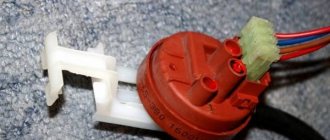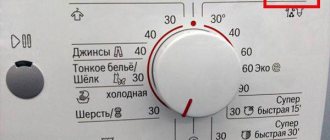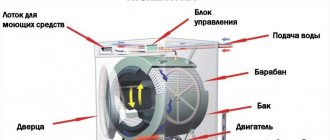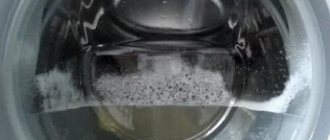Often during operation a problem arises when the washing machine does not heat the water or does not heat it enough. If such a malfunction occurs, most modern models with an automatic self-diagnosis system stop working and display a fault code on the display. Simpler units usually continue the washing process in cold water, which can make it difficult to detect this breakdown in a timely manner.
The first obvious sign of insufficient or complete absence of heating during the washing process is poorly washed laundry. You can check and fix this malfunction yourself or with the assistance of a repairman from the service center.
Fault detection methods
There are several ways to test an automatic washing machine for the functionality of the heating element. The simplest and most informative diagnostic option is carried out in the following sequence:
- Place a small amount of cotton laundry in the drum.
- Select the automatic washing mode, in which the temperature of the liquid inside the machine should be at least 60˚C.
- Press the “Start” button.
- After the household appliance has been operating for about 20 minutes, place your palm on the glass part of the loading hatch.
If you feel warmth when touched, this indicates that the washing machine has heated the water inside the drum.
Some models of washing machines, Bosch and Zanussi have a large number of washing programs. Therefore, if for some reason it was not possible to determine in time the heating of the liquid in the manner described above, and the draining of the liquid has already begun, then it is enough to touch the drain hose to determine the temperature of the water removed from the washing machine.
To finally make sure that the machine is heating water, you should pay attention to the electric meter. The heating element of a washing machine can consume 2 or more kilowatts of electricity per hour, so its inclusion in operation will be indicated by the frequent blinking of the control LED and the movement of numbers in the far right row of the meter.
In order to avoid getting false results during this experiment, it is recommended to turn off all devices that consume electric current, including the refrigerator and lighting elements that use incandescent lamps.
If during the experiments it was possible to determine the performance of the electric heating element, then you can continue to operate the washing machine as usual. Otherwise, you will need to find out why the liquid is not heating.
Part Search
If you have doubts about the performance of the heating element, you will have to “ring” it with a multimeter. First you need to find the device itself in the machine. Its location largely depends on the manufacturer’s brand, for example, in Indesit and Ariston it is located at the back, in models from Bosch and Siemens it is at the front.
Having in hand the factory wiring diagram for the heating element in the washing machine, you can speed up the search.
If there are no instructions, then we look for the heater ourselves:
- We examine the back wall of the machine. Often a large panel indicates a heating element located behind it;
- put the body on its side or tilt it back to look into the bottom and try to detect the heating element near the washing tub;
- remove the back cover and carefully inspect the space around the tank;
- We take a flashlight, shine a light through the inside of the drum and try to determine by eye the location of the heater.
The task is simplified by the fact that the heating element is always in the washing tub. It is only necessary to specify its location. There is no need to remove the device - you can “ring” the heater without removing it. We’ll tell you how exactly later.
The washing machine does not heat the water: reasons
If, as a result of the test, the machine door does not heat up and the meter does not respond to turning on the household appliance, then this “behavior” of the washing machine may be caused by the following malfunctions:
- Incorrect connection of the household appliance.
- Wrong washing program selected.
- The heating element has burned out.
- Thermostat is faulty.
- The control unit is faulty.
If you have just purchased a household appliance and this is the first start-up, then there may be a manufacturing defect or the wires may have come loose during transportation. Such a malfunction can be eliminated by contacting a sales organization to replace or repair the washing machine.
Many washing programs have a limitation on maximum water heating, so choosing such an algorithm for the operation of the device may lead to a false determination that this function is not working. To eliminate this possibility, you should carry out additional testing of the equipment by repeating the procedure, but choosing a different washing program.
The heating element can burn out in almost any washing machine, but such a nuisance especially often happens with Indesit equipment. In addition, frequent washing in hard water without the use of special softening chemicals can also cause damage to the heating element. It is almost impossible to reliably identify a malfunction of the heating element without removing this element from the household appliance, so if you do not have experience in repairing complex household appliances, you should contact a specialized workshop or call a specialist to your home.
A malfunctioning thermostat can also cause the water in the washing machine to not heat up. To check the functionality of this element, you also cannot do without removing it from the body of the household appliance.
The malfunction of the control unit is classified as complex, but you should start diagnosing the software module only after the heating element and thermostat have been checked. In some cases, you can fix the malfunction of this element yourself, but if the control program has failed, then restoring the washing machine’s functionality will be impossible without the involvement of a qualified specialist.
Prevention of breakdowns
- To avoid this problem, you should take simple measures in advance, without waiting until the washing machine stops heating the water.
- Carefully study the instructions before operating the washing machine;
- Add water softeners to the washing liquid. This will allow you to face the scale problem later;
- Also, to combat scale, regularly run it at idle speed with special means that help clean the machine from deposits;
- If possible, clean the water level sensor tube without waiting until the washing machine stops heating the water.
If you follow these simple rules, then the trouble in question may not happen.
- Is it possible to wash a blanket in a washing machine?
- How to wash a sweater so that it shrinks
Tips and tricks
- To determine the heating of water in devices with vertical loading, it is enough to touch the side surface of the device while the device is operating. To detect a breakdown, in this case, you can also record the counter readings before turning on the washing machine and after the end of the washing cycle. The changes must be at least 0.5 kW. The temperature of the drain hose can also be used to determine the presence or absence of heating in household appliances of this type.
- If, as a result of “thermal” tests, it was not possible to detect signs of heating and you decide to independently remove the internal elements for inspection, then you should definitely turn off the power to the washing machine and turn off the water supply.
- In order not to miss the moment when the washing machine heats the liquid, it is recommended to touch the glass part of the door several times during washing. It should also be borne in mind that if the washing process is completed and the rinsing procedure has begun, then, in many cases, the glass and hose of the household appliance will be cold.
- The performance of the heating element can be determined using a multimeter. A working device will show a resistance of several tens of ohms. You can read about how to find out if the heater is working properly in specialized literature, but the simplest test is using a light bulb and a twelve-volt battery. If you pass an electric current through a heating element, the lamp connected to it will light up.
- If the heating element is fully operational, but there is a significant layer of scale on its surface, then to restore the functionality of the device you will need to completely clean the metal of calcium deposits.
How to determine whether a washing machine is heating water or not is no longer a secret. In most cases, the diagnostic methods listed above allow you to accurately determine the performance of the heating element.
Heating element test
First, disconnect the washing machine from the power supply and turn off the water tap. Next, we provide free access to the heater and, if necessary, remove the back wall or bottom. Next, take a multimeter and start testing.
- We photograph the heating element to record the connected wiring and eliminate errors during future installation.
- Disconnect all connected wires.
- We set up the multimeter to measure resistance and set the selector to 200 Ohms.
- We attach the probes to the contacts.
- Let's evaluate the result.
Heating element test
First, disconnect the washing machine from the power supply and turn off the water tap. Next, we provide free access to the heater and, if necessary, remove the back wall or bottom. Next, take a multimeter and start testing.
- We photograph the heating element to record the connected wiring and eliminate errors during future installation.
- Disconnect all connected wires.
- We set up the multimeter to measure resistance and set the selector to 200 Ohms.
- We attach the probes to the contacts.
- Let's evaluate the result.
A working heater always shows a fixed value of 26.8 ohms. Slight deviations from the norm within +-5 are possible. If one is displayed on the screen, then a line break has occurred inside the heating element and a part change is necessary. When the tester showed “0” or another number less than 1, a short circuit was detected and the element burned out.
Voltage drops in the electrical network and hard water with an abundance of impurities lead to problems with the heater.
Often, checking for resistance is not enough, since if the external condition is good, the dielectric inside can leak into the housing and cause a current leak. To ensure safe operation of the machine, it is recommended to check the heating element for breakdown. It is enough to turn the tester into buzzer mode, attach one probe to the contact, and attach the second to the body of the multimeter. If there is no piercing squeak, everything is fine. Otherwise, it is necessary to urgently change the part and not use the machine until the repair is completed.
Reasons for failure of popular brands
In addition to technical reasons, each product model of the machine has its own design nuances, the failure of which can lead to breakdown:
- Bosh machine. The weak point in the German Bosh, Whirlpool and Miele machines may be the water heating level sensor. During the washing process, the tube of the device very often becomes clogged with lint or wool. This negatively affects the functioning of the level relay and control module. The latter does not signal that the required water level has been reached and does not turn on the heating element for further heating. You can clean the sensor tube yourself, but in this case a specialist will be able to carry out a preventive inspection and prevent other breakdowns.
- Indesit machine. The Italian manufacturer tried to adapt its equipment for Russian users. That is why the Indesit brand washing machine has a standard design that does not create any special problems during use.
- LG washing machine. The not-so-high quality of the parts of the LG model means that regular washing can be carried out only at low temperature conditions, otherwise frequent temperature changes during heating and cooling will disrupt the operation of the heating element. The user must use a gentle temperature regime that does not exceed 60 degrees Celsius.
- Ardo technology. Everyone knows that the quality of drinking water in Russia is much worse than in European regions. Of course, this negatively affects the service life of Ardo household appliances from Italian manufacturers, which are designed for milder operating conditions. In addition to strong water hardness, the operation of the heating element is negatively affected by sudden voltage surges and exposure to low-quality washing powders.
- Samung machines are considered to be of average quality. At the same time, they are protected from significant damage and have both strengths and weaknesses. As with any similar technology, some difficulties may arise in the operation of Samsung. Most often, failures are associated with: Physical wear and tear of components made of plastic or rubber - such materials are susceptible to moisture and sudden temperature changes, which leads to malfunctions of the washing machine;
- Impaired sealing of hatches - with frequent use, it may begin to open or close poorly;
- Failures in electronics - if sudden changes in voltage levels occur, the washing machine may fail, and a message about a characteristic error will appear on the display. You should not troubleshoot such problems yourself.
How quickly does it heat up?
A normally functioning heating element with an average power rating in the new technology allows you to bring the water temperature to 90 degrees in an average of 15 minutes. If the heater is particularly powerful, this happens much faster, in 5-7 minutes. However, the device will consume more electricity.
Some users note that even for a quick wash at 40 degrees, the water heats up too slowly. Why this happens is quite simple to explain. Electric heaters are fragile and susceptible to external influences. Flint sticks to the heating element, burns, and limescale appears. The thicker the layer of deposits, the less heat transfer from the heating part.
Important! A heating element coated with scale works 2 times slower, and over time it stops functioning altogether, and the owner has to change the element.
For correct and uninterrupted operation, certain measures must be taken. Firstly, it is important to use special filtration systems to soften the water. This is both safer and cheaper than special chemical compounds sold in hardware stores. Secondly, many experts recommend periodically cleaning the “insides” of the washing machine with a concentrated solution of citric acid.











